LG Electronics USA E405F Cellular/PCS GSM/WCDMA Phone with WLAN and Bluetooth User Manual LG E405f UK 120430 indd
LG Electronics MobileComm USA, Inc. Cellular/PCS GSM/WCDMA Phone with WLAN and Bluetooth LG E405f UK 120430 indd
Users Manual

User Guide
LG-E405f
P/N : MFL00000000 (1.0) www.lg.com
ENGLISH

Part 15.21 statement
" Change or Modifications that are not expressly approved by the manufacturer could void
the user's authority to operate the equipment. “
Part 15.105 statement
This equipment has been tested and found to comply with the limits for a class B digital
device, pursuant to Part 15 of the FCC Rules.
These limits are designed to provide reasonable protection against harmful interference in
a residential installation. This equipment generates uses and can radiate radio frequency
energy and, if not installed and used in accordance with the instructions, may cause harmful
interference to radio communications. However, there is no guarantee that interference will
not occur in a particular installation. If this equipment does cause harmful interference or
television reception, which can be determined by turning the equipment off and on, the user
is encouraged to try to correct the interference by one or more of the following measures:
- Reorient or relocate the receiving antenna.
- Increase the separation between the equipment and receiver.
- Connect the equipment into an outlet on a circuit different from that to
which the receiver is connected.
- Consult the dealer or an experienced radio/TV technician for help.
This Device is not intended for the sale in U.S.A

Part 15 Class B Compliance
This device and its accessories comply with part15 of FCC rules and
ICES-003 Class B digital apparatus requirements for Industry Canada.
Operation is subject to the following two conditions:
(1) This device & its accessories may not cause harmful interference.
(2) This device & its accessories must accept any interference received,
including interference that may cause undesired operation.
Body-worn Operation
This device has been tested for typical body-worn operations
with the distance of 0.39inches (1.0cm) from the user’s body.
To comply with FCC RF exposure requirements, a minimum separation distance
of 0.39inches(1.0cm) must be maintained from the user's body.
For example, this device must be maintained from the user's body with
an appropriatebelt-clip accessory.
Additionally, Belt clips, holsters & other body-worn accessories may not contain
metallic components.

Important notice
Please check to see whether any problems
you encountered with your phone are
described in this section before taking the
phone in for service or calling a service
representative.
1. Phone memory
When available space in your phone memory
is less than 10%, your phone cannot receive
new messages. You need to check your
phone memory and delete some data, such
as applications or messages, to make more
memory available.
Managing applications
In the Home screen, touch the
Applications tab, then select Settings >
Applications > Manage applications.
Once all applications appear, scroll to
and select the application you want to
uninstall.
Tap Uninstall, then touch OK to uninstall
the application you selected.
1
2
3

2. Optimising battery life
Extend your battery's life between charges
by turning off features you don't need
to run constantly in the background. You
can monitor how applications and system
resources consume battery power.
Extending your battery's life
Turn off radio communications you are not
using. If you are not using Wi-Fi, Bluetooth
or GPS, turn them off.
Reduce screen brightness and set a
shorter screen timeout.
•
•
Turn off automatic syncing for Gmail,
Calendar, Contacts and other applications.
Some applications you have downloaded
may cause your battery life to be reduced.
Checking the battery charge level
In the Home screen, touch the
Applications tab, then select Settings >
About phone > Status.
The battery status (Charging, Not
charging) and level (percentage charged)
is displayed at the top of the screen.
•
•
1
2

Monitoring and controlling what uses
the battery
In the Home screen, touch the
Applications tab, then select Settings >
About phone > Battery use.
Battery usage time is displayed at the
top of the screen. It tells you how long it
has been since you last connected to a
power source or, if connected to a power
source, how long you were last running
on battery power. The body of the screen
lists applications or services using battery
power, from greatest amount to least.
1
2
3. Installing an open source
operating system
If you install and use an open source
operating system (OS) on your phone
rather than using the OS provided by the
manufacturer, your phone may malfunction.
WARNING
If you install and use an OS other than
the one provided by the manufacturer,
your phone is no longer covered by the
warranty.
Important notice

WARNING
To protect your phone and personal
data, only download applications from
trusted sources, such as Android
Market. If there are improperly installed
applications on your phone, your phone
may not work normally or a serious
error may occur. You must uninstall
those applications and all their data and
settings from the phone.
4. Using unlock pattern
Set unlock pattern to secure your phone.
This opens a set of screens that guide
you through how to draw a screen unlock
pattern.
Caution: Create a Google account before
setting an unlock pattern.

WARNING
Precautions to take when using
pattern lock.
It is very important to remember the
unlock pattern you set. You will not be
able to access your phone if you use
an incorrect pattern 5 times. You have
5 opportunities to enter your unlock
pattern, PIN or password. If you have
used all 5 opportunities, you can try
again after 30 seconds.
When you can’t recall your unlock
Pattern, PIN, or Password:
If you have forgotten pattern: If you logged
in to your Google account on the phone but
failed to enter the correct pattern 5 times,
tab the Forgot pattern button. You are then
required to log in with your Google account
to unlock your phone.
If you have not created a Google account
on the phone or you forgot it, you have to
perform a Hard reset.
If you have forgotten PIN or Password: If
you forgot your PIN or Password, you need
to do Hard reset.
Important notice

Caution: If you perform a hard reset, all user
applications and user data are deleted.
Caution: If you perform a
hard reset, all user applications and user
data will be deleted. Please remember
to back up any important data before
performing a hard reset.
Turn the power off.
Press and hold the following keys at the
same time for 8 seconds: Power/Lock
Key + Down Volume Key.
When FACTORY HARD RESET screen is
displayed, release the keys.
1
2
3
Press the Power/Lock Key to confirm to
delete all user data, and press the Volume
Keys to cancel.
5. Using the hard reset
If it does not restore to the original condition,
use hard reset to initialise your phone.
When the phone is turned off, touch and
hold the Volume down key + Power key for
over ten seconds. When the screen shows
the LG logo, release the Power key.
After the screen shows the hard reset
screen, release the other keys.
4

Leave your phone for at least a minute while
it performs the hard reset, then your phone
will be turned on.
Caution: If you perform a hard reset, all user
applications and user data are deleted. This
cannot be reversed. Remember to back
up any important data before performing a
hard reset.
6. Connecting to Wi-Fi networks
To use Wi-Fi on your phone, you need to
access a wireless access point or “hotspot.”
Some access points are open and you can
simply connect to them. Others are hidden
or use security features; you must configure
your phone to be able to connect to them.
Turn off Wi-Fi when you're not using it to
extend the life of your battery.
Important notice

Turning Wi-Fi on and connecting to a
Wi-Fi network
In the Home screen, touch the
Applications tab, then select Settings >
Wireless & networks > Wi-Fi settings.
Touch Wi-Fi to turn it on and begin
scanning for available Wi-Fi networks.
A list of available Wi-Fi networks is
displayed. Secured networks are indicated
by a lock icon.
Touch a network to connect to it.
1
2
•
3
If the network is open, you are asked to
confirm that you want to connect to that
network by touching Connect.
If the network is secure, you're asked to
enter a password or other credentials. (Ask
your network administrator for details)
The status bar displays icons that indicate
Wi-Fi status.
•
•
4

7. Opening and switching
applications
Multitasking is easy with Android because
you can keep more than one application
running at the same time. There’s no
need to quit an application before opening
another. Use and switch between several
open applications. Android manages each
application, stopping and starting them as
needed to ensure that idle applications don’t
consume resources unnecessarily.
Stopping applications
In the Home screen, touch the
Applications tab, then select Settings >
Applications > Manage applications >
select Running.
Scroll to the desired application and touch
Stop to stop it.
TIP! To return to recent applications,
touch and hold the Home key. The
screen then displays a list of the
applications you used recently.
1
2
Important notice

8. Installing PC software (LG PC
Suite)
“LG PC Suite” PC application is a program
that helps you connect your device to a PC
via a USB cable and Wi-Fi. Once connected,
you can use the functions of your device
from your PC.
With your “LG PC Suite” PC application,
you can...
Manage and play your media contents
(music, movie, pictures) on your PC.
Send multimedia contents to your device.
•
•
Synchronises data (schedules, contacts,
bookmarks) in your device and PC.
Backup the applications in your device.
Update the softwares in your device.
Backup and restore the device.
Play multimedia contents of your PC from
other device.
NOTE: You can use the Help menu from
the application to fi nd out how to use
your “LG PC Suite” PC application.
•
•
•
•
•

Installing “LG PC Suite” PC application
“LG PC Suite” PC application can be
downloaded from the webpage of LG.
Go to www.lg.com and select a country of
your choice.
Go to Support > Mobile Phone Support
> Select the Model (LG-E405f).
Click PC Sync from Download, and
click WINDOW PC Sync Download to
download “LG PC Suite” PC software.
1
2
3
System requirements for “LG PC Suite”
PC software
OS: Windows XP 32 bit(Service pack 2),
Windows Vista 32 bit/64 bit, Windows 7
32 bit/64 bit
CPU: 1GHz or higher processors
Memory: 512MB or higher RAMs
Graphic card: 1024 x 768 resolution, 32
bit color or higher
HDD: 100 MB or more free hard disk
space (More free hard disk space may be
needed depending on the volume of data
stored.)
•
•
•
•
•
Important notice

Required software: LG integrated drivers.
NOTE
LG Integrated USB Driver
LG integrated USB driver is required
to connect an LG device and PC and
installed automatically when you install
“LG PC Suite” PC software.
•
9. Synchronising your phone to a
Computer
Data of your device and PC can be
synchronised easily with “LG PC Suite”
PC application for your convenience.
Contacts, schedules, and bookmarks can be
synchronised.
The procedure is as follows:
Connect your device to PC. (Use a USB
cable or Wi-Fi connection.)
After connection, run the program
and select the device section from the
category on the left side of the screen.
1
2

Click [Personal information] to select.
Select the checkbox of contents to
synchronise and click the Sync button.
10. Transferring music, photos
and videos using USB mass
storage devices
In the Home screen, touch the
Applications tab, then select Settings >
Storage to check out the storage media.
(If you want to transfer files from or to a
memory card, insert a memory card into
the phone.)
3
4
1
Connect the phone to your PC using the
USB cable.
USB connection mode list will appear, and
select USB storage option.
Open the removable memory folder on
your PC. You can view the mass storage
content on your PC and transfer the files.
Copy the files from your PC to the drive
folder.
When you are finished, select “Charge
only” option to disconnect the phone.
2
3
4
5
6
Important notice

11. Hold your phone straight up
Hold your mobile phone straight up, as
you would a regular phone. The LG-E405f
has an internal antenna. Be careful not to
scratch or damage the back of the phone, as
that causes loss of performance.
While making/receiving calls or sending/
receiving data, avoid holding the lower part
of the phone where the antenna is located.
Doing so may affect call quality.
12. When the screen freezes
If the screen freezes or the phone does not
respond when you try to operate it:
Remove the battery, reinsert it, then turn the
phone on. If it still does not work, please
contact the service centre.
13. Do not connect your phone
when you turn on/off your
PC.
Make sure you disconnect the data cable
between your phone and PC; leaving it
connected might cause errors on your PC.
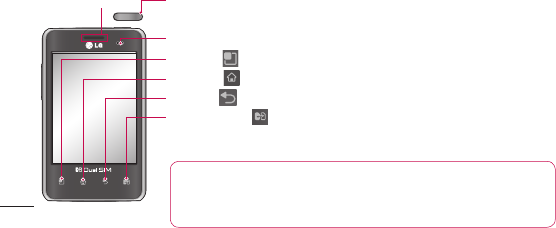
To turn on your phone, press and hold the Power key for 3 seconds.
To turn off the phone, press and hold the Power key for 3 seconds, then touch Power off and OK.
Menu key – Check what options are available.
Home key – Return to home from any screen.
Back key – Return to the previous screen.
SIM Switch Key – Touch the key for SIM1/SIM2 selection (Selected SIM is
marked by square box on RSSI icon). Touch and Hold the key to go to Dual SIM
settings.
Speaker/Receiver Power/Lock key – Switch your phone on/off by pressing and holding this key.
Turn off and lock the screen.
Proximity sensor
Getting to know your phone
NOTE: Proximity sensor When receiving and making calls, the proximity sensor
automatically turns the backlight off and locks the touch keypad by sensing when the
phone is near your ear. This extends battery life and prevents the touch keypad from
activating unintentionally during calls.
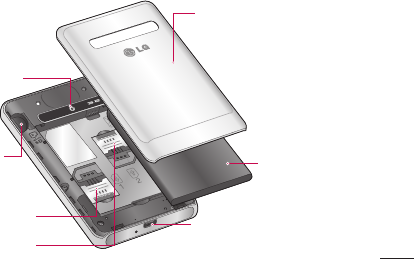
SIM2 card slot
microSD memory card slot
Camera lens
Charger, micro USB cable
connector
Battery
Back cover
SIM1 card slot
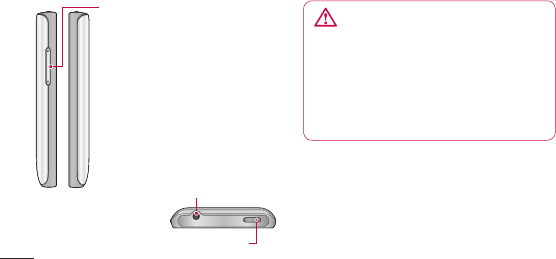
Volume keys
On the home screen: control
ringer volume.
During a call: control your In-
Call volume.
When playing a track: control
volume continuously.
•
•
•
Stereo earphone connector
Power/Lock key
WARNING
Placing a heavy object on the phone
or sitting on it can damage its LCD
and touch screen functions. Do not
cover the protective fi lm on the LCD’
s proximity sensor. This may cause the
sensor to malfunction.
Getting to know your phone
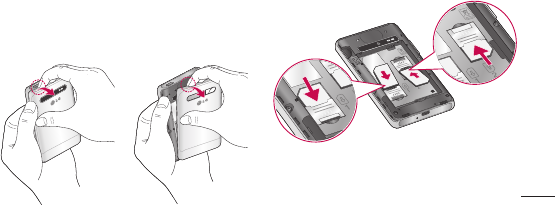
Installing the SIM card and
battery
To remove the back cover, hold the phone
in your hand firmly. With the other hand,
firmly press your thumb on the back
cover. Now lift off the back cover.
1
Slide the SIM card into the SIM card slot.
Make sure the gold contact area on the
card is facing downwards.
2
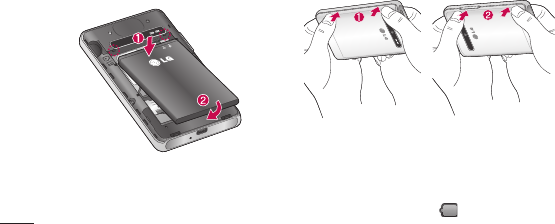
Insert the battery by aligning the gold
contacts on the phone and the battery.
3
Replace the back cover of the phone.
Charging your phone
Insert the charger, then plug it into an
electrical outlet. Your LG-E405f must be
charged before you see .
4
Getting to know your phone
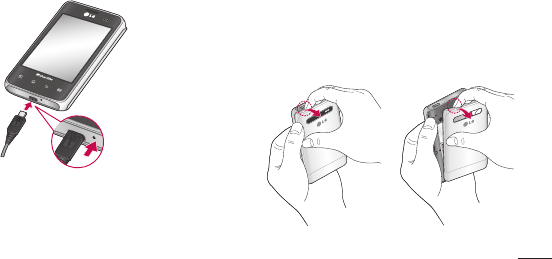
NOTE: The battery
must be fully
charged initially to
improve battery
lifetime.
Installing the memory card
NOTE: The LG-E405f supports memory
cards up to 32 GB.
To insert a memory card:
Turn the phone off before inserting or
removing a memory card. Remove the
back cover.
1
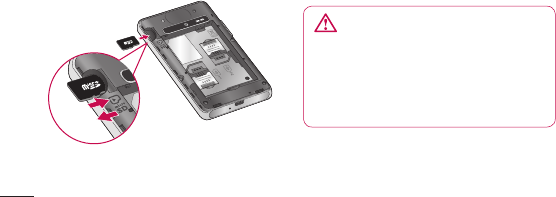
Insert the memory card into the slot.
Make sure the gold contact area is facing
downwards.
2
Removing a memory card
Carefully remove the memory card out of
the slot.
WARNING
Do not insert or remove the memory
card when the phone is on. Doing so
may damage the memory card as well
as your phone, and the data stored on
the memory card may be corrupted.
Getting to know your phone

Formatting the memory card
Your memory card may already be
formatted. If it isn’t, you must format it
before you can use it.
NOTE: All fi les on the card are deleted when
you format the card.
In the Home screen, touch the
Applications tab to open the applications
menu.
Scroll to and touch Settings > Storage.
Touch Unmount SD card and touch OK
to confirm.
1
2
3
Touch Erase SD card, then confirm your
choice.
If you have set a pattern lock, input
the pattern lock then select Erase
everything. The card is then formatted
and ready to use.
NOTE: If there is content on your memory
card, the folder structure may be different
after formatting since all the fi les will be
deleted.
4
5

Touch screen tips
Here are some tips on how to navigate
around your phone.
Touch – To choose a menu/option or open
an application, touch it.
Touch and hold – To open an options menu
or grab an object you want to move, touch
and hold it.
Drag – To scroll through a list or move
slowly, drag across the touch screen.
Flick – To scroll through a list or move
quickly, flick across the touch screen (drag
quickly and release).
NOTE:
To select an item, touch the centre of the
icon.
Do not press too hard; the touch screen
is sensitive enough to pick up a light, firm
touch.
Use the tip of your finger to touch the
option you want. Be careful not to touch
any other keys.
•
•
•
Your Home screen

Lock your phone
When you are not using the LG-E405f, press
the power key to lock your phone. This helps
prevent accidental presses and saves battery
power.
Also, if you do not use the phone for a while,
the Home screen or another screen you are
viewing is replaced with the lock screen to
conserve battery power.
If there are any programs running when you
set the pattern, they may be still running
in Lock mode. It is recommended that
you exit all programs before entering the
Lock mode to avoid unnecessary charges
(e.g. phone calls, Web access and data
communications).
Setting an unlock pattern: you can draw
your own unlock pattern by connecting the
dots.
If you set a pattern, the phone screen locks.
To unlock the phone, draw the pattern that
you set on the screen.
Caution: When you set an unlock pattern,
you need to create your Gmail account fi rst.
Caution: If there are more than 5 pattern
drawing errors in a row, you cannot unlock

the phone. In this case, refer to the point-4
under the Important Notice.
Unlock screen
Whenever your LG-E405f is not in use, it
returns to the lock screen. Drag your finger
from bottom to top to unlock the screen.
Silent mode
In the notification drawer, touch to
change mode.
Home
Simply swipe your finger to the left or right
to view the panels.
You can customise each panel with widgets,
shortcuts (to your favourite applications),
folders and wallpaper.
NOTE: Some screen images may be
different depending on your phone provider.
In your Home screen, you can view quick
keys at the bottom of the screen. Quick
keys provide easy, one-touch access to the
functions you use the most.
Your Home screen

Touch the Phone icon to bring up the
touch screen dialpad to make a call.
Touch the Contacts icon to open your
contacts.
Touch the Messaging icon to access
the messaging menu. This is where you can
create a new message.
Touch the Applications tab at the
bottom of the screen. You can then view all
your installed applications.
To open the desired application, simply touch
the icon in the applications list.
NOTE: Preloaded applications may differ
according to your phone’s software or your
service provider.
Adding widgets to your Home
screen
You can customise your Home screen by
adding shortcuts, widgets or folders to it. For
more convenience using your phone, add
your favourite widgets to the Home screen.
In the Home screen, touch the Menu key
and select Add. Or touch and hold the
empty part of the home screen.
1

In the Add to Home screen menu, touch
the type of item you want to add.
For example, select Folders from the list
and tap it.
You then see a new folder icon on the
Home screen. Drag it to the desired
location on the desired panel, then take
your finger off the screen.
TIP! To add an application icon to the
Home screen from the Applications
menu, touch and hold the application
you want to add.
2
3
4
TIP!
To remove an application icon from
the Home screen, touch and hold the
icon you want to remove, then drag it to
.
NOTE: You cannot delete preloaded
applications. (Only their icons can be
deleted from the screen.)
Returning to recently-used
applications
Touch and hold the Home key. The
screen displays a pop-up with icons of
applications you used recently.
1
Your Home screen

Touch an icon to open the application.
Or touch the Back key to return to the
current application.
Using Dual SIM
When two SIM cards are inserted on your
phone, the SIM cards information are
displayed on your notification drawer. When
you touch the SIM switch key, currently
active SIM is switched.
NOTE: If only one SIM card is inserted
or one SIM is off, SIM switching is not
available, and the SIM switch key has no
2
action. During a call, sending a message or
using a data service, the other SIM’s RSSI
might be displayed as ‘No service’ due to
the network service status.
WARNING
If you are outside of the service area,
it may cause your device to consume
more battery power.
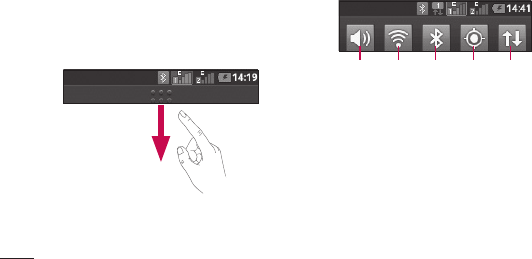
Notification drawer
The notification drawer runs across the top
of your screen.
Data
connectivity
GPSBluetooth
Wi-Fi
Sound/
Vibrate/
Silent
Touch and slide the notification drawer down
with your finger.
Or, in the Home screen, touch the Menu
key and select Notifications. Here you can
check and manage sound, Wi-Fi, Bluetooth
and GPS as well as other notifications.
Your Home screen

Viewing the status bar
The status bar uses different icons to display
phone information such as signal strength,
new messages, battery life and active
Bluetooth and data connections.
Below is a table explaining the meaning of
icons you’re likely to see in the status bar.
[Status bar]

Icon
Description
No SIM card
No signal
Airplane mode
Connected to a Wi-Fi
network
Wired headset
Call in progress
Call hold
Icon
Description
Speakerphone
Phone microphone is
muted
Missed call
Bluetooth is on
Connected to a Bluetooth
device
System warning
Alarm is set
Icon
Description
New voicemail
Ringer is silenced
Vibrate mode
Battery fully charged
Battery is charging
Data in and out /
Default data network
Phone is connected to
PC via USB cable
Your Home screen

Icon
Description
Downloading data
Uploading data
GPS is acquiring
Receiving location data
from GPS
3 more notifications not
displayed
Data is syncing
Download finished
Icon
Description
New Gmail
New Google Talk
message
New message
Song is playing
Upcoming event
USB tethering is active
Portable Wi-Fi hotspot
is active
Icon
Description
Both USB tethering and
portable hotspot are
active

Onscreen keyboard
You can enter text using the onscreen keyboard.
The onscreen keyboard appears automatically
on the screen when you need to enter text. To
manually display the keyboard, simply touch a
text field where you want to enter text.
Using the keypad & entering text
Tap once to capitalise the next letter you
type. Double tap for all caps.
Tap to switch to the numeric and
symbol keyboard. You can also touch and
hold this tab to view the Settings menu.
Tap to insert an emoticon when writing a
message.
Tap to enter a space.
Tap to create a new line in the message field.
Tap to delete the previous character.
Tap to hide the onscreen keyboard.
Entering accented letters
When you select French or Spanish as the
text entry language, you can enter special
French or Spanish characters (e.g. “á”).
For example, to input "á", touch and hold
the "a" key until the zoom-in key grows
bigger and displays characters from different
languages. Then select the special character
you want.
Your Home screen

When you first turn on your phone, you have
the opportunity to activate the network, to
sign into your Google account and how you
want to use some Google services.
To set up your Google account :
* Sign into a Google account from the
prompted set up screen.
OR
* Applications > select a Google application,
such as Gmail > select Next > select
Create to create a new account.
If you have a Google account, enter your e-mail
address and password, then touch Sign in.
Once you have set up your Google account
on your phone, your phone automatically
synchronises with your Google account on
the Web.
Your contacts, Gmail messages, calendar
events and other information from these
applications and services on the web are
synchronised with your phone. (This depends
on your synchronisation settings.)
After signing in, you can use Gmail and take
advantage of Google services on your phone.
Google account setup

With Wi-Fi, you can use high-speed Internet
access within the coverage of the wireless
access point (AP).
Enjoy wireless Internet using Wi-Fi, without
extra charges.
Turning on Wi-Fi
In the Home screen, open the notification
drawer and touch .
Or touch Application > Settings >
Wireless & networks, then Wi-Fi .
Connecting to Wi-Fi
Choose the Wi-Fi network you want to
connect to. If you see , you need to enter
a password to connect.
NOTE:
If you are outside the Wi-Fi coverage area
and choose 3G connection, additional
charges may apply.
If your phone goes into sleep mode when
connected to Wi-Fi, the Wi-Fi connection is
automatically disabled.
In this case, if your phone has access to
3G data, it may connect to the 3G network
•
•
•
Wi-Fi

automatically and additional charges may
apply.
The LG-E405f supports WEP, WPA/WPA2-
PSK and 802.1x EAP security. If your Wi-Fi
service provider or network administrator
sets encryption for network security,
enter the key into the pop-up window.
If encryption is not set, this pop-up
window is not shown. Obtain the key from
your Wi-Fi service provider or network
administrator.
•
Sharing your phone’s data
connection
You can share your phone’s mobile data
connection with a single computer via a
USB cable (USB tethering). You can also
share your phone’s data connection with up
to eight devices at a time by turning your
phone into a portable Wi-Fi hotspot.
When your phone is sharing its data
connection, an icon appears in the status
bar and as an ongoing notification in the
notifications drawer.
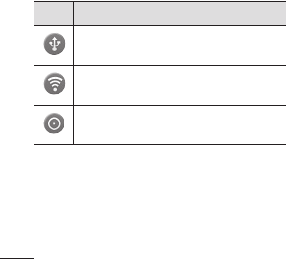
Icon
Description
USB tethering is active
Portable Wi-Fi hotspot is active
Both USB tethering and portable hotspot
are active
For the latest information about tethering
and portable hotspots, including supported
operating systems and other details, visit
http://www.android.com/tether.
NOTE: Additional costs may be incurred
when connecting and using online services.
Check data charges with your network
provider.
USB tethering & portable Wi-Fi
hotspot settings
In the Home screen, touch the
Applications tab and select Settings.
Touch Wireless & networks and select
Tethering & portable hotspot.
Choose options that you want to adjust.
1
2
3
Wi-Fi

USB tethering – Tick to share your phone’s
mobile network data connection with your
computer via a USB connection.
Portable Wi-Fi hotspot – Tick to share your
phone’s mobile network data connection as
Wi-Fi sharing.
Help – Opens a dialog with information
about USB tethering and portable Wi-Fi
hotspots as well as information on where to
learn more.
To share your phone’s data
connection via USB
If your computer is running Windows 7 or a
recent distribution of some flavours of Linux
(such as Ubuntu), you don’t usually need to
prepare your computer for tethering. But if
you’re running an earlier version of Windows
or another operating system, you may need
to prepare your computer to establish a
network connection via USB. For the most
current information about which operating
systems support USB tethering and how to
configure them, visit http://www.android.
com/tether.

USB tethering and data sharing
You can’t share your phone’s data
connection and microSD card via USB
at the same time. If you are using your
USB connection to make your microSD
card available to your computer, you must
disconnect it first.
Use the USB cable that came with your
phone to connect your phone to your
computer.
In the Home screen, touch the
Applications tab and select Settings.
1
2
Touch Wireless & networks and select
Tethering & portable hotspot.
Tick USB tethering.
The phone starts sharing its mobile
network data connection with your
computer via the USB connection. An
ongoing notification is added to the
status bar and notifications drawer.
Deselect USB tethering to stop sharing
your data connection. Or just disconnect
the USB cable.
3
4
•
5
Wi-Fi

To share your phone’s data
connection as a portable Wi-Fi
hotspot
In the Home screen, touch the
Applications tab and select Settings.
Touch Wireless & networks and select
Tethering & portable hotspot.
Tick Portable Wi-Fi hotspot.
After a moment, the phone starts
broadcasting its Wi-Fi network name
(SSID) so you can connect to it with up
to eight computers or other devices. An
ongoing notification is added to the
status bar and notifications drawer.
1
2
3
•
When Portable Wi-Fi hotspot is ticked,
you can change its network name or
secure it.
Deselect Portable Wi-Fi hotspot to stop
sharing your data connection via Wi-Fi.
To rename or secure your
portable hotspot
You can change the name of your phone’s
Wi-Fi network name (SSID) and secure its
Wi-Fi network.
In the Home screen, touch the
Applications tab and select Settings.
•
4
1

Touch Wireless & networks and select
Tethering & portable hotspot.
Ensure Portable Wi-Fi hotspot is ticked.
Touch Portable Wi-Fi hotspot settings.
Touch Configure Wi-Fi hotspot.
The Configure Wi-Fi hotspot dialog
opens.
You can change the network SSID (name)
that other computers see when scanning
for Wi-Fi networks.
You can also touch the Security menu to
configure the network with Wi-Fi Protected
2
3
4
5
•
•
•
Access 2 (WPA2) security, with a pre-
shared key (PSK).
If you touch the WPA2 PSK security
option, a password field is added to the
Configure Wi-Fi hotspot dialog. If you
enter a password, you will need to enter
that password when you connect to the
phone’s hotspot with a computer or other
device. Or touch Open in the Security
menu to remove security from your Wi-Fi
network.
•
Wi-Fi

ATTENTION!
If you set the security option as Open,
you cannot prevent unauthorised usage
of online services by other people and
additional charges can be incurred.
To avoid unauthorised usage, you are
advised to keep the security option
active.
Touch Save.
6
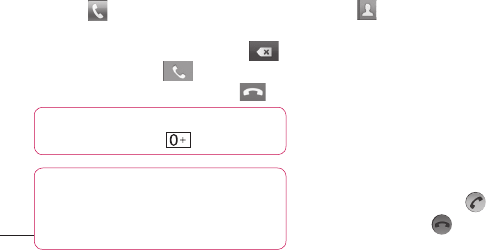
Making a call
Touch to open the keypad.
Enter the number using the keypad. To
delete a digit, touch the Clear icon .
Touch the Call icon to make a call.
To end a call, touch the End icon .
TIP!
To enter “+” to make international
calls, touch and hold .
TIP!
If both the SIM cards are inserted
and activated, SIM1/SIM2 can be
selected on Dial Screen by using SIM
switching key.
1
2
3
4
Calling your contacts
Touch to open your contacts.
Scroll through the contact list or enter the
first letter(s) of the contact you want to
call by touching Search.
In the list, touch the contact which you
want to call and tap on the number or call
icon to make call.
Answering and rejecting a call
When the screen is locked and your phone
rings, drag the Answer icon to the right.
Drag the Decline icon to the left to
reject an incoming call.
1
2
3
Calls

Adjusting call volume
To adjust the in-call volume during a call,
use the Volume Up and Down key on the left
side of the phone.
Making a second call
During your initial call, tap .
Dial the number, or search your contacts.
Touch the Call icon to connect
the call.
Both calls are displayed on the call
screen. Your initial call is locked and put
on hold.
1
2
3
4
Touch the displayed number to toggle
between calls. Or touch Merge calls
to make a conference call.
To end active calls, touch End.
NOTE: You are charged for each call you
make.
Viewing your call logs
In the Home screen, touch and choose
the Call log tab.
View a complete list of all dialled, received
and missed voice calls.
5
6
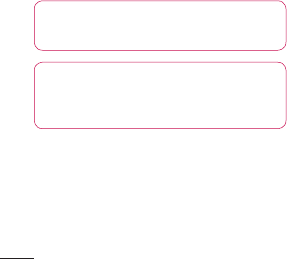
TIP!
Touch any call log entry to view the
date, time and duration of the call.
TIP! Touch the Menu key, then touch
Delete all to delete all the recorded
items.
Call settings
You can configure phone call settings such
as call forwarding and other special features
offered by your carrier.
In the Home screen, touch the
Applications tab to open the applications
menu.
Scroll and touch Settings.
Tap Call settings and choose the options
that you want to adjust.
1
2
3
Calls

Add contacts to your phone and synchronise
them with the contacts in your Google
account or other accounts that support
contact syncing.
Searching for a contact
In the Home screen
Touch to open your contacts.
Touch Search and enter the contact
name using the keyboard.
1
2
Adding a new contact
Touch , enter the new contact’s
number, then touch the Menu key. Touch
Add to contacts and then Create new
contact.
If you want to add a picture to the new
contact, touch .
Choose from Capture picture or Pick
from Gallery.
Select the contact type by touching .
Touch a category of contact information
and enter the details about your contact.
Touch Save.
1
2
3
4
5
Contacts

Favorite contacts
You can classify frequently called contacts
as favorites.
Adding a contact to your favorites
Touch to open your contacts.
Touch a contact to view its details.
Touch the star to the right of the contact’s
name. The star turns gold.
1
2
3
Removing a contact from your favorites
list
Touch to open your contacts.
Touch the Groups tab, select Favorites
at the top of the list and choose a contact
to view its details.
Touch the gold star to the right of the
contact’s name. The star turns grey
and the contact is removed from your
favourites.
1
2
3
Contacts

Moving Contacts from your Old
Device to your New Device
Export your contacts as a CSV file from
your old device to your PC using a PC
sync program.
Install “LG PC Suite” PC application on
the PC. Run the program and connect
your device to the PC using a USB cable.
From the top of the screen, select Device
> Import personal information >
Import contacts.
1
2
A pop-up to open a contacts file will
appear.
Select a contacts file and click Open.
A pop-up to import a new contact from
PC to the contacts in the device will
appear.
If the contacts in the device and new
contacts from PC are different, select a
contact you want to import from PC.
Click the [OK] button to import a new
contact from PC to the device.
3
4
5
6
7

Messaging
Your LG-E405f combines SMS and MMS
into one intuitive, easy-to-use menu.
Sending a message
Touch icon on the home screen, and
touch New message to open a blank
message.
Enter a contact name or contact number
in the To field. As you enter the contact
name, matching contacts appear. You can
touch a suggested recipient. You can add
multiple contacts.
1
2
NOTE: You will be charged for a text message
for every person you send the message to.
Touch Enter message field and start to
compose your message.
Touch the Menu key to open the options
menu. Choose from Call, View contact,
Add subject, Discard, Reply by and
More.
Touch Send to send your message.
The message screen opens, with your
message after Recipient Name/Number.
Responses appear on the screen. As you
view and send additional messages, a
message thread is created.
3
4
5
6
Messaging

TIP! If both the SIM cards
are inserted and activated, SIM1/SIM2
can be selected on Dial Screen by using
SIM switching key.
WARNING
The 160-character limit may vary from
country to country depending on
how the SMS is coded and in what
language.
WARNING
If an image, video or audio fi le is added
to an SMS, it will be automatically
converted into an MMS , and you will be
charged accordingly.
NOTE:
When you get an SMS message
during a call, there will be a ring notifi cation.
Threaded box
Messages (SMS, MMS) exchanged
with another party can be displayed
in chronological order so that you can
conveniently see an overview of your
conversation.

Using Smilies
Liven up your messages using Smilies.
When writing a new message, touch the Menu
key, then choose More > Insert smiley.
Changing your message settings
Your LG-E405f message settings are
predefined, so you can send messages
immediately. You can change the settings
based on your preferences.
WARNING
In this mode, the MMS Client device
guides the user in creating and sending
messages with content belonging to
the Core MM Content Domain. This
guidance is provided through warning
dialogs.
NOTE: Cell broadcast settings can be
supported only for SIM1.
Messaging

Opening Email and the Accounts
Screen
You can use the Email application to read
email from services other than Google Mail.
The Email application supports the following
account types: POP3, IMAP and Exchange.
Managing an email account
In the Home screen, touch Email, then
select the Email Service Provider.
A setup wizard opens to help you add an
email account. After the initial setup, Email
displays the contents of your Inbox (if you
have only one account) or the Accounts
screen (if you have multiple accounts).
The Accounts screen
The Accounts screen lists your Combined
Inbox and each of your email accounts.
Open the Email application. If you’re not
on the Account screen, touch the Menu
Key and touch Accounts.
Select the Email service provider.
1
2
Email

- Touch to open your Combined Inbox,
with messages received to all of your
accounts.
- Touch to open a list of just your starred
messages.
- Touch the folder icon to open the
account’s folders.
You can touch an account to view its Inbox.
The account from which you send email by
default is indicated with a tick.
To open your Combined Inbox
If you have configured Email to send and
receive email from more than one account,
you can view all messages sent to all
accounts in your Combined Inbox.
Touch Email.
Touch Combined inbox (in the Accounts
screen). Messages in the Combined Inbox
are colour coded along their left sides, by
account, using the same colours that are
used for your accounts in the Accounts
screen.
1
2
Email

Only your account’s most recent emails are
downloaded to your phone. To download
more (earlier) email messages, touch Load
more messages at the bottom of the emails
list.
Composing and Sending Email
To compose and send a message
While in the Email application, touch the
Menu key and touch Compose.
Enter an address for the message’s intended
recipient. As you enter text, matching
addresses are offered from your Contacts.
Separate multiple addresses with commas.
1
2
Touch the Menu key and then touch Add
Cc/Bcc to send copy or blind copy of the
mail to other contacts/email addresses.
Enter the text of the message.
Touch the Menu key and touch Add
attachment to send a file with the
message.
Touch the Send button.
If you’re not ready to send the message,
touch the Save as draft button to save it
in a Drafts folder. Touch a draft message
in a Drafts folder to resume working on
it. Your message will also be saved as
a draft if you touch the Back key
3
4
5
6

before sending it. Touch the Discard
button to abandon and delete a message,
including any saved drafts. If you aren’ t
connected to a network, for example,
if you’re working in airplane mode, the
messages that you send are stored in
your Outbox folder until you’re connected
to a network again. If it contains any
pending messages, the Outbox is
displayed on the Accounts screen.
Please note that messages sent using an
Exchange account will not be located on the
phone; they will, however, be located on the
Exchange server itself.
If you want to see your sent messages in the
Sent folder, then touch the Menu key and
touch on Folders then touch on Sent folder
and select Refresh from the options menu.
TIP! When a new email arrives in the
inbox, you will receive a notifi cation by
sound or vibration.
Email

Working with Account Folders
Each account has Inbox, Outbox, Sent, and
Drafts folders. Depending on the features
supported by your account’s service provider,
you may have additional folders.
Adding and Editing email
Accounts
To add an email account, touch the
Applications tab and select Email.
Select MS Exchange or Others, and
enter account settings.
1
2
If an email account is already set up, you
need to touch the Menu key then tap
Add account from Accounts screen.
Enter a name for the account, confirm
how you want your name to appear in
outgoing mail, then touch the Done
button.
To change an account’s settings
Open the Accounts screen.
Touch and hold the account whose
settings you want to change. In the menu
that opens, touch Account settings.
3
4
1
2

To delete an email account
Open the Accounts screen.
Touch and hold the account you want to
delete.
Touch Remove account in the menu that
opens.
Touch the OK button in the dialog box
to confirm that you want to delete the
account.
1
2
3
4
Email
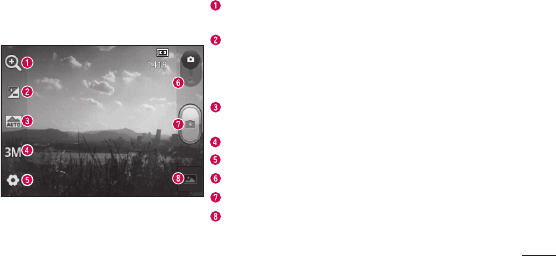
Zoom - Zoom in or zoom out. Alternatively you can use the side
volume keys.
Brightness - This defines and controls the amount of sunlight
entering the image. Slide the brightness indicator along the bar
towards “-” to lower the brightness of the image or towards “+” to
increase it.
Scene mode - Choose from Auto, Portrait, Landscape, Sports,
Sunset and Night.
Image size - Touch to set the size (in pixels) of the picture you take.
Settings - Touch this icon to open the advanced settings menu.
Video mode - Slide this icon down to switch to video mode.
Taking a photo
Gallery - Touch to view the last photo you captured. This enables you
to access your gallery and view saved photos from within camera
mode.
Camera
Getting to know the
viewfinder

Taking a quick photo
Open the Camera application.
Hold the phone horizontally and point
the lens towards the subject you want to
photograph.
Touch the capture button.
1
2
3
Once you’ve taken the photo
Your captured photo appears on the screen.
Share
Touch to share your photo using
Bluetooth, Gmail, Google+,
Messaging and Picasa.
Set as
Touch to use the image as a
Contact icon or Wallpaper.
Rename
Touch to edit the name of the
picture just taken.
Camera

Touch to delete the image.
Touch to take another photo
immediately. Your current photo is
saved.
Touch to view the last photo you
captured as well as the gallery.
Using the advanced settings
In the viewfinder, touch to open all
advanced options.
Change camera settings by scrolling through
the list. After selecting the option, touch the
Back key.
ISO – The ISO rating determines the
sensitivity of the camera’s light sensor.
The higher the ISO, the more sensitive the
camera is. This is useful in darker conditions
when you cannot use the flash.
White balance – Choose from Auto,
Incandescent, Sunny, Fluorescent and
Cloudy.
Color effect – Choose a colour tone for your
new photo.
Timer – The self-timer allows you to set a
delay after the capture button is pressed.
Select Off, 3 secs., 5 sec or 10 secs. This
is ideal if you want to be in the photo.

Shutter sound – Select one of four shutter
sounds.
Auto review – If you turn Auto review on,
it automatically shows you the picture you
just took.
Tag location – Activate to use your phone’s
location-based services. Take pictures
wherever you are and tag them with the
location. If you upload tagged pictures to a
blog that supports geotagging, you can see
the pictures displayed on a map.
NOTE: This function is only available when
GPS is active.
Storage – Choose whether to save your
photos to the phone memory or to the
external memory.
– Restore all camera default settings.
– Touch whenever you want to know
how this function operates. This provides you
with a quick guide.
TIP!
When you exit the camera, some
settings return to their defaults, such as
white balance, color effect and timer .
Check these before you take your next
photo.
Camera

TIP!
The Settings menu is superimposed
over the viewfi nder, so when you
change elements of the image colour or
quality, you see a preview of the image
change behind the Settings menu.
Viewing your saved photos
Access your saved photos while in Camera
mode. Just touch and touch the screen.
You then see Slideshow and Menu.
TIP!
Flick left or right to view other
photos or videos.
- Touch to see a slideshow.
- Touch to share the contents or delete a
photo. Touch More for more options.
Details – Check information on the
content.
Show on map
Set as – Set as a contact icon or
wallpaper.
Crop – Crop your photo. Move your
finger across the screen to select the
area.
Rotate Left / Rotate Right – Rotate
left or right.
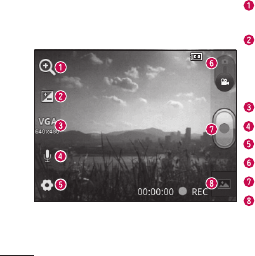
Zoom - Zoom in or zoom out. Alternatively you can use the side
volume keys.
Brightness - This defines and controls the amount of sunlight
entering the video. Slide the brightness indicator along the bar
towards “-” to lower the brightness of the video or towards “+” to
increase it.
Video size - Touch to set the size (in pixels) of the video you record.
Audio recording - Choose Mute to record a video without sound.
Settings - Touch this icon to open the advanced settings menu.
Camera mode - Slide this icon up to switch to camera mode.
Start recording
Gallery - Touch to view the last video you recorded. This enables
you to access your gallery and view your saved videos from within
video mode.
Getting to know the
viewfinder
Video camera
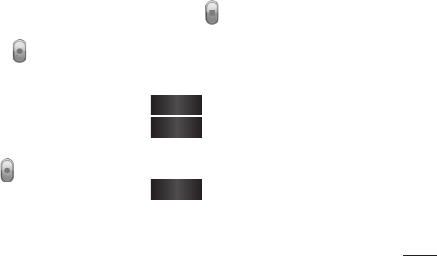
Shooting a quick video
Slide the Camera mode button down and
the icon changes to .
The video camera viewfinder appears on
the screen.
Holding the phone horizontally, point the
lens towards the subject you want to
capture in your video.
Touch the Record button once to start
recording.
REC appears at the bottom of the
viewfinder with a timer showing the
length of the video.
1
2
3
4
5
Touch on the screen to stop recording.
After shooting a video
A still image representing your video will
appear on the screen.
Play Touch to play the video.
Share Touch to share your video using
Bluetooth, Gmail, Messaging
and YouTube.
Rename Touch to edit the name of the
selected video.
6

Touch to delete the video you just made.
Confirm by touching OK. The viewfinder
reappears.
Touch to shoot another video right away.
Your current video is saved.
Touch to view the last recorded video as
well as the gallery.
Using the advanced settings
Using the viewfinder, touch to open all
the advanced options.
Adjust the video camera setting by scrolling
through the list. After selecting the option,
touch the Back key.
White balance – White balance ensures
that the white areas in your video are
realistic. To enable your camera to adjust
the white balance correctly, you may need to
determine the light conditions. Choose from
Auto, Incandescent, Sunny, Fluorescent
and Cloudy.
Video camera

Color effect – Choose a colour tone to use
for your new view.
Auto review – Auto review automatically
shows you the video you just recorded.
Storage – Choose whether to save your
video clip to the phone memory or to the
external memory.
– Restore all video camera default
settings.
– Touch if you want to know how this
function operates. This provides you with a
quick guide.
Watching your saved videos
In the viewfinder, touch .
Your gallery appears on the screen.
Touch a video once to bring it to the
front of the gallery. It starts playing
automatically.
Adjusting the volume when
viewing a video
To adjust the volume of a video while it is
playing, use the volume keys on the left-
hand side of the phone.
1
2
3

Preloaded App
There are useful applications preloaded on
the Preloaded Apps. To use the application,
you need to install the application to your
phone first.
NOTE: Preloaded applications may differ
according to your phone’s software or your
service provider.
Gallery
Touch the Applications tab, then select
Gallery. Open a list of catalogue bars that
store all your multimedia files.
View mode
Touch Gallery. Folder view is displayed.
Touch any folder and it turns to grid view
mode. If you tap a photo, it changes into full
view mode.
Timeline view
LG-E405f Gallery provides a timeline view
of your photos and videos. In grid view
mode, drag to the right and the date
you took your photos is displayed, starting
with the most recent. If you select a specific
date, all the photos you took on that day are
grouped.
Multimedia

Music
Your LG-E405f has a built-in music
player that lets you play all your favourite
tracks. To access the music player, touch
Applications, then touch Music.
Playing a song
In the Home screen, touch the
Applications tab and select Music.
Touch Songs.
Select the song you want to play.
Touch to pause the song.
1
2
3
4
Touch to skip to the next song.
Touch to go back to the beginning
of the song. Touch twice to return to
the previous song.
To change the volume while listening to
music, press the up and down volume keys
on the left-hand side of the phone.
Touch and hold any song in the list. It
displays Play, Add to playlist, Use as
ringtone, Delete, Details, Share and
Search as options.
5
6

NOTE:
Music fi le copyrights may be
protected by international treaties and
national copyright laws.
Therefore, it may be necessary to obtain
permission or a licence to reproduce or
copy music.
In some countries, national laws prohibit
private copying of copyrighted material.
Before downloading or copying the fi le,
check the national laws of the relevant
country concerning the use of such
material.
Transferring files using USB
mass storage devices
To transfer files using USB devices
Connect the LG-E405f to a PC using a
USB cable.
USB connection mode list will appear, and
select USB storage option.
Open the removable memory folder on
your PC. You can view the mass storage
content on your PC and transfer the files.
Copy the files from your PC to the drive
folder.
1
2
3
4
Multimedia

When you are finished, select “Charge
only” option to disconnect the phone.
How to transfer music/video files
to your phone
Connect your phone to the PC using the
USB cable. In the Home screen, touch
and drag down the notification drawer.
Select USB connection mode > USB
storage, and select Open folder to view
files from Removable Disk pop up which
appears in PC .
If you didn't install LG Android Platform
5
1
Driver on your PC, you must set it up
manually.
For more information, refer to
'Transferring files using USB mass
storage devices'.
Transfer music or video files from the PC
to the phone's removable storage.
You can copy or move files from your
PC to your phone's removable storage
using a card reader.
If there is a video file with a subtitle file
(*.srt file with the same name as the
video file), place it in the same folder
2
•
•

to display subtitles automatically when
playing the video file.
When downloading music or video files,
copyrights must be secured. Note that
corrupted files or files with incorrect
extensions may damage your phone.
•
Sending data from your phone
using Bluetooth
Sending data using Bluetooth You can
use Bluetooth to send data by running a
corresponding application, not from the
Bluetooth menu as on most other mobile
phones.
* Sending pictures: Run the Gallery
application, then select Picture > Menu.
Click Share, then select Bluetooth. Check
whether Bluetooth is turned on, then select
Scan for devices. Choose the device you
want to send data to from the list.
Multimedia

* Exporting contacts: Run the Contacts
application. Touch the address you want
to export to. Touch the Menu key and
select Share > Bluetooth. Check whether
Bluetooth is turned on, then select Scan
for devices. Choose the device you want
to send data to from the list.
* Sending multi-selected contacts: Run
the Contacts application. To select more
than one contact touch the Menu key and
touch Share. Select the contacts you want
to send or touch Select all option from
top > Select Share > Bluetooth > Enable
Bluetooth and select Scan for devices >
Choose the device you want to send data
from the list.
* Connecting to FTP (only FTP server
is supported on this handset): Select
Settings > Wireless & networks
> Bluetooth settings. Select the
Discoverable box so you can search for
your phone on other devices. Find the FTP
service and connect to the FTP server.
If you want to search for this phone from
other devices, go to Settings > Wireless
& networks > Bluetooth settings. Select
the Discoverable box. The box is cleared
after 120 seconds.
•

Setting your alarm
In the Home screen, touch the
Applications tab and select Clock.
If you want to add a new alarm, touch
and select Add alarm.
Set the time to turn on the alarm. After
you set the time, the LG-E405f lets you
know how much time is left before the
alarm will sound.
Set Repeat, Ringtone or Vibrate, then
add a label to name the alarm. Touch
Done.
1
2
3
4
NOTE: to change alarm settings on alarm
list screen, touch the Menu key and
select Settings. You can adjust the below
options: Alarm in silent mode, Alarm
volume, Snooze duration and Side button
behaviour.
Using your calculator
In the Home screen, touch the
Applications tab and select Calculator.
Touch the number keys to enter numbers.
For simple calculations, touch the
function you want (+, –, x or ÷) followed
by =.
1
2
3
Utilities

For more complex calculations, touch the
Menu key, touch the Advanced panel,
then choose sin, cos, tan, log and so on.
Adding an event to your
calendar
In the Home screen, touch the
Applications tab and select Calendar.
To check the event, touch the date. Touch
and hold if you want to add a new event.
Touch New event.
Touch What then enter the event name.
Check the date and enter the time you
want your event to start and finish.
4
1
2
3
Also, touch Where then enter the
location.
If you want to add a note to your event,
touch Description and enter the details.
If you want to repeat the alarm, set
Repetition, and set Reminders, if
necessary.
Touch Done to save the event in the
calendar. A coloured square in the
calendar marks all days that have saved
events. An alarm sounds at the event
start time to help you stay organised.
4
5
6
7

Changing your calendar view
In the Home screen, touch the
Applications tab and select Calendar.
Touch the Menu key.
Select the calendar view for a particular
day, week or month.
Voice recorder
Use the voice recorder to record voice
memos or other audio files.
1
2
Recording a sound or voice
In the Home screen, touch the
Applications tab and select Voice
Recorder.
Touch to begin recording.
Touch to end the recording.
Touch to listen to the recording.
NOTE: touch to access your album.
You can listen to the saved recording.
Notice: the available recording time may
differ from the real time.
1
2
3
4
Utilities

Sending the voice recording
Once you have finished recording, you
can send the audio clip by touching
Menu > Share.
Choose from Bluetooth, Gmail
Messaging. When you select Gmail and
Messaging, the voice recording is added
to the message, then you write and send
the message normally.
1
2
Polaris Office
Polaris Office is a professional mobile office
solution that lets users conveniently view
various types of office documents, including
Word, Excel and PowerPoint files, anywhere,
anytime, using their mobile devices.
Managing files
Polaris Office provides mobile users with
convenient file management features,
including copying, pasting, renaming and
deleting files and folders right on the device.

Viewing files
Mobile users can now easily view a wide
variety of file types, including Microsoft
Office documents and Adobe PDF, right
on their mobile devices. When viewing
documents using Polaris Office, the objects
and layout remain the same as in their
original documents.
App Manager
You can manage your applications with App
Manager. You can easily check the number
of currently running applications and shut
down applications. You can also uninstall
the applications you have installed on your
device.
Utilities

Browser
Browser gives you a fast, full-colour world
of games, music, news, sport, entertainment
and much more, right on your mobile phone.
Wherever you are and whatever you enjoy.
NOTE: additional charges apply when
connecting to these services and
downloading content. Check data charges
with your network provider.
Using the web toolbar
Touch to go backwards one page.
Touch to go forwards one page to the
one you connected to after the current
page. This is the opposite of what
happens when you touch the Back key,
which goes to the previous page.
Touch to show all your open windows.
Touch to add a new window
Add/show bookmark and show Most
visited, Read it later and History.
The Web

Using options
Touch the Menu key to view options.
Read it later – Add the current web
page in read it later.
Add RSS feed – Add the current web
page to the RSS feed.
Share page – Allows you to share the
web page with others.
Find on page – Allows you to find
letters or words on the current web
page.
Select text – Allows you to copy any
text from the web page.
More
Home page: Go to the Home page.
Set home page: Set the current web
page as your Home page.
Add shortcut to home: Add the shortcut
of the current web page to the Home
screen.
Page info: Displays the web page
information.
•
•
•
•
The Web

Downloads: Displays your download
history.
Settings: Change web browser settings.
TIP! To return to the previous web page,
touch the Back key.
•
•

In the Home screen, touch the Applications
tab then scroll to and touch Settings.
Dual SIM settings
You can configure Dual SIM settings.
When two SIM cards are inserted on your
phone, the SIM cards information are
displayed. Touch to tick. This turns on the
selected SIM to active.
NOTE: It is not allowed to turn off both SIM
cards simultaneously.
Data enabled – touch to tick. This enable
data access over the mobile network.
Default data network – You can change
the default data network. All mobile packet
services (Web, MMS, Email, etc) will use SIM
selected on this value.
When only one SIM card is inserted, the
default data network is set as the inserted
SIM and it is not allowed to change.
NOTE: When airplane mode is on, dual SIM
settings is disabled.
Data roaming – touch to tick. Allows you to
connect to data services when roaming.
Settings

Wireless & networks
Here, you can manage Wi-Fi and Bluetooth.
You can also set up mobile networks and
switch to airplane mode.
Airplane mode – After switching to airplane
mode, all wireless connections are disabled.
Wi-Fi – Touch to select: This turns on Wi-Fi
to connect to available Wi-Fi networks.
Wi-Fi settings – Allows you to set up and
manage wireless access points. Set network
notification, or add a Wi-Fi network. The
advanced Wi-Fi settings screen is accessed
from the Wi-Fi settings screen. Touch the
Menu key and touch Advanced.
TIP! How to obtain the MAC address
To set up a connection in some wireless
networks with MAC fi lters, you may
need to enter the MAC address of your
LG-E405f into the router.
You can fi nd the MAC address in
the following user interface: Touch
Applications > Settings > Wireless &
networks > Wi-Fi settings, and touch
the Menu key. Then select Advanced >
MAC Address.

Bluetooth – Touch to select: This turns on
Bluetooth to connect to Bluetooth devices.
Bluetooth settings – Set device name &
discoverable mode, scan for other devices.
Or, check a list of Bluetooth devices that
you’ve previously configured and those
detected when the phone last scanned for
Bluetooth devices.
Tethering & portable hotspot – You can
configure the USB tethering and portable Wi-
Fi hotspot settings.
VPN settings – Displays the list of Virtual
Private Networks (VPNs) that you’ve
previously configured. Allows you to add
different types of VPN.
Mobile networks – Set options for data
roaming, network mode & operators, access
point names (APNs) and so on.
Call settings
< Fixed dialing numbers >
Select Fixed dialing numbers to turn on
and compile a list of numbers that can be
called from your phone. You’ll need your
PIN2, which is available from your operator.
Only numbers within the fixed dial list can be
called from your phone.
Settings

< Voicemail >
Voicemail service – Allows you to select
your carrier’s voicemail service.
Voicemail settings – If you are using your
carrier’s voicemail service, this option allows
you to enter the phone number to use for
listening to and managing your voicemail.
< Other call settings >
Call forwarding – Choose whether to divert
all calls, when the line is busy, when there is
no answer or when you have no signal.
Call barring – Select when you would like
calls to be barred. Enter the call barring
password. Please check with your network
operator about this service.
Call duration – View the duration of calls
including last call, all calls, dialled calls and
received calls.
Additional settings – This lets you change
the following settings:
Caller ID: Choose whether to display your
number on an outgoing call (This service is
network dependent; some operators do not
support this function).
Call waiting: If call waiting is activated, the
handset will notify you of an incoming call

while you are on another call (depending on
your network provider).
< Common >
Excuse messages – When you want to
reject a call, you can send a quick message
using this function. This is useful if you need
to reject a call during a meeting.
Call reject – Allows you to set the call reject
function. Choose from Off, Reject on list or
Reject all calls.
Sound
< General >
Silent mode – Allows you to mute all
sounds (including call and notification
ringtones) except the audio from music and
videos and any alarms you have set. You
must mute media and alarm sounds in their
own applications.
Vibrate – Allows you to set your phone to
vibrate when you receive an incoming call.
Volume – Allows you to set the volume for
ringtones, media and alarms. If you deselect
the option to use the incoming call volume
Settings

for notifications, you can set the volume for
incoming calls and notifications separately.
< Incoming calls >
SIM1 Phone ringtone/SIM2 Phone
ringtone – Allows you to set your default
incoming call ringtone.
< Notifications >
Notification ringtone – Allows you to set
your default notification ringtone.
< Feedback >
Audible touch tones – Allows you to set the
phone to play tones when using the dialpad
to dial numbers.
Audible selection – Allows you to set your
phone to play a sound when you touch
buttons, icons and other onscreen items that
react to your touch.
Screen lock sounds – Allows you to set
your phone to play a sound when locking
and unlocking the screen.
Display
Brightness – Adjust the screen brightness.
Auto-rotate screen – Set to switch
orientation automatically when you rotate
the phone.

Animation – Set to display an animation.
Screen timeout – Set the time for screen
timeout.
Power Saver
Activate Power Saver – Allow you to set
an activating time when starting power saver
mode.
<Power saving items>
Set to switch to turn off desired items: Wi-
Fi, AutoSync, Bluetooth, GPS, Animation,
Brightness.
Brightness adjustment – If you select
Brightness, set the brightness percentage.
<Battery>
Battery use – See what has been using
the battery.
Location & security
Use wireless networks – If you select Use
wireless networks, your phone determines
your approximate location using Wi-Fi and
mobile networks. When you select this
option, you’re asked whether you consent to
allowing Google to use your location when
providing these services.
Settings

Use GPS satellites – If you select Use
GPS satellites, your phone determines your
location to street level accuracy.
Set up screen lock – Set an unlock
pattern to secure your phone. Opens a set
of screens that guide you through drawing
a screen unlock pattern. You can set a PIN
or password instead of a pattern or leave
it as None.
When you turn on your phone or wake up
the screen, you're asked to draw your unlock
pattern to unlock the screen.
Set up SIM card lock – Set up SIM card
lock or change the SIM PIN.
Visible passwords – Select to show
passwords as you type them or deselect to
hide passwords as you type them.
Select device administrators – View or
deactivate device administrators.
Use secure credentials – Allows you to
access secure certificates.
Install from SD card – Choose to install
encrypted certificates from your SD card.
Set password – Set or change the
credential storage password.

Clear storage – Clear credentials for all
content and reset password.
Applications
You can manage applications.
Unknown sources – Default setting to
install non-Market applications.
Manage applications – Manage and
remove installed applications.
Running services – Check services that are
currently running.
Storage use – View storage used by
applications.
Battery usage – See what has been using
the battery.
Development – Set options for application
development.
Accounts & sync
< General sync settings >
Background data – Permits applications to
synchronise data in the background, whether
or not you are actively working in them.
Settings

Deselecting this setting can save battery
power and lowers (but does not eliminate)
data usage.
Auto-sync – Permits applications to
synchronise, send and receive data to their
own schedule.
< Manage accounts >
List of all Google accounts and other
accounts you’ve added to your phone.
If you touch an account in this screen, its
account screen opens.
Privacy
Change the settings for managing your
settings and data.
Back up my data: Set to back up your
settings and application data to the Google
server.
Automatic restore: Set to restore your
settings and application data when the
applications are reinstalled on your device.
Factory data reset: Reset your settings
to the factory default values and delete
all your data. If you reset the phone in
this way, you are prompted to reenter the
•
•
•

same information as when you first started
Android.
Storage
< Internal memory >
Check total available internal memory space.
Touch Erase internal memory if you want
to delete all data from the internal memory.
< SD card >
Check total available SD card space. Touch
Unmount SD card for safe removal. Erase
SD card if you want to delete all data from
the SD card.
< System memory >
Checks the available space.
Language & keyboard
Set local language and region as well as
keyboard settings.
Voice input & output
< Voice input >
Voice recognizer settings – Use the
Voice recognizer settings to configure the
Android voice input feature.
Settings

Language: Opens a screen where you
can set the language you use for speech
to enter text.
SafeSearch: Opens a dialog where you
can set whether you want the Google
SafeSearch filter to block some results.
Block offensive words: When deselected,
Google voice recognition will recognise
and transcribe words many people
consider offensive, when you use speech
to enter text. When selected, Google
voice recognition replaces those words
in transcriptions with a placeholder
comprised of star symbols ( * ).
•
•
•
< Voice output >
Text-to-speech settings – Use the Text-
to-speech settings to configure the Android
text-to-speech synthesiser for applications
that can use this feature.
NOTE: if you don’t have speech synthesiser
data installed, only the Install voice data
setting is available.
Listen to an example: Plays a brief
sample of the speech synthesiser, using
your current settings.
Always use my settings: Tick to use the
settings on this screen in place of speech
•
•

Settings
synthesiser settings available in other
applications.
Default Engine: Opens a dialog where
you can set the text-to-speech application
you want to use, if you have more than
one installed.
Install voice data: If your phone does
not have speech synthesiser data
installed, this connects to Android Market
and guides you through the process
of downloading and installing the data.
This setting is not available if the data is
already installed.
•
•
Speech rate: Opens a dialog where
you can select how quickly you want the
synthesiser to speak.
Language: Opens a dialog where you can
select the language of the text you want
the synthesiser to read. This is particularly
useful in combination with Always use
my settings to ensure that text is spoken
correctly in a variety of applications.
Pico TTS: Configure the Pico TTS
settings.
•
•
•

Accessibility
Use the Accessibility settings to configure
accessibility plug-ins you have installed on
your phone.
NOTE: requires additional plug-ins.
Connectivity
Default connection mode – You can set the
desired mode (Charge only, USB storage,
PC software and USB tethering).
Always ask – Checkmark this if you want to
see USB connection mode popup whenever
USB cable is connected.
Wi-Fi connection – Checkmark this to use
LG PC Suite with Wi-Fi connection.
Please note that Wi-Fi network should
be connected for LG PC Suite via Wi-Fi
connection in Wireless & networks settings.
Date & time
Use Date & time settings to set your
preference for how dates are displayed. You
can also use these settings to set your own
time and time zone rather than obtaining the
current time from the mobile network.

About phone
View legal information and check phone
status and software version.
Settings

Phone software update
LG Mobile phone software update from
the Internet
For more information about using this
function, please visit the http://update.
lgmobile.com or http://www.lg.com/
common/index.jsp select country and
language.
This feature allows you to update the
firmware on your phone to a newer version
conveniently from the Internet without
needing to visit a service centre. This feature
is only available if and when LG makes the
newer version of the firmware available for
your device.
As the mobile phone firmware update
requires the user’s full attention for the
duration of the update process, please make
sure you check all instructions and notes
that appear at each step before proceeding.
Please note that removing the USB data
cable or battery during the upgrade may
seriously damage your mobile phone.
NOTE: LG reserves the right to make
fi rmware updates available only for selected
models at its own discretion and does
Software update

not guarantee the availability of the newer
version of the fi rmware for all handset
models.
LG Mobile Phone software update via
Over-the-Air (OTA)
This feature allows you to update the
firmware of your phone to the newer version
conveniently via OTA without connecting the
USB data cable. This feature is only available
if and when LG makes the newer version of
the firmware available for your device.
First, you can check the software version
on your mobile phone: Settings > About
phone > Software update > Check now
for update.
You can also delay the update by 1 hour, 4
hours, 8 hours or 24 hours. In this case, the
application will notify you to update when the
time is up. You can also rearrange an update
manually.
NOTE: This feature is dependent on
the network service provider, region or
countries.
Software update

DivX Mobile
ABOUT DIVX VIDEO: DivX
®
is a digital video
format created by DivX, LLC, a subsidiary
of Rovi Corporation. This is an official DivX
Certified
®
device that plays DivX video. Visit
divx.com for more information and software
tools to convert your files into DivX videos.
ABOUT DIVX VIDEO-ON-DEMAND: This
DivX Certified
®
device must be registered
in order to play purchased DivX Video-
on-Demand (VOD) movies. To obtain your
registration code, locate the DivX VOD
section in your device setup menu. Go to
vod.divx.com for more information on how to
complete your registration.
DivX Certified
®
to play DivX
®
video up to
320x240.
DivX
®
, DivX Certified
®
and associated
logos are trademarks of Rovi Corporation
or its subsidiaries and are used under
licence.

Notice:
Open Source Software
To obtain the corresponding source
code under GPL, LGPL, MPL and
other open source licences, please visit
http://opensource.lge.com/
All referred licence terms, disclaimers
and notices are available for download
with the source code.
Software update
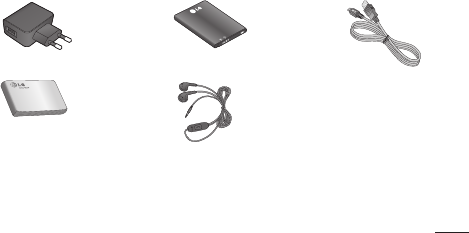
These accessories are available for use with the LG-E405f. (Items described below may be optional.)
Travel adapter Battery Data cable
Connect your
LG-E405f and PC.
User Guide
Learn more about
your LG-E405f.
Stereo headset
NOTE:
Always use genuine LG accessories.
Failure to do this may void your warranty.
Accessories may vary in different regions.
•
•
•
Accessories

Ambient temperatures
Max: +55°C (discharging), +45°C (charging)
Min: -10°C (discharging)
Technical data

This chapter lists some problems you might encounter while using your phone. Some
problems require you to call your service provider, but most are easy to fix yourself.
Message Possible causes Possible corrective measures
SIM error
There is no SIM card in
the phone or it is inserted
incorrectly.
Make sure that the SIM card is correctly inserted.
No network
connection/
Losing
network
Signal is weak or you’re
outside the carrier network.
Operator applied new
services.
Move towards a window or into an open area. Check the
network operator coverage map.
Check whether the SIM card is more than 6~12 months
old. If so, change your SIM at your network provider's
nearest branch. Contact your service provider.
Troubleshooting

Message Possible causes Possible corrective measures
Codes do not
match
To change a security code,
you will need to confirm the
new code by re-entering it.
The two codes you have
entered do not match.
If you forget the code, contact your service provider.
Any
application
cannot be set
Not supported by service
provider or registration
required.
Contact your service provider.
Calls not
available
Dialling error.
New SIM card inserted.
Pre-paid charge limit
reached.
New network not authorised.
Check for new restrictions.
Contact service provider or reset limit with PIN2.
Troubleshooting

Message Possible causes Possible corrective measures
Phone cannot
be switched
on
On/Off key pressed too briefly.
Battery is not charged.
Battery contacts are dirty.
Press the On/Off key down for at least two seconds.
Charge battery. Check charging indicator on the display.
Clean the battery contacts.
Charging
error
Battery is not charged.
Outside temperature is too
hot or cold.
Contact problem
No voltage
Charger defective
Wrong charger
Battery defective
Charge battery.
Make sure phone is charging at a normal temperature.
Check the charger and connection to the phone. Check the
battery contacts and clean them if necessary.
Plug the charger into a different socket.
If the charger does not warm up, replace it.
Only use original LG accessories.
Replace battery.

Message Possible causes Possible corrective measures
Number not
permitted
The Fixed dialling number
function is on. Check the Settings menu and turn the function off.
Impossible
to receive /
send SMS &
picture
Memory full Delete some messages from the phone.
Files not
opening Unsupported file format Check the file formats that can be supported.
SD card not
working
FAT16, FAT32 file system
supported
Check SD card file system via card reader, or format SD
card using the phone.
Troubleshooting

Message Possible causes Possible corrective measures
The screen
does not turn
on when I
receive a call.
Proximity sensor problem
If you use any protection tape or case, check to see if it has
covered the area around the proximity sensor. Make sure
that the area around the proximity sensor is clean.
No sound Vibration mode Check the settings status of the sound menu to make sure
you are not in vibrate or silent mode.
Hang up or
freeze
Intermittent software
problem
Remove the battery, insert it again and switch on the phone.
Try to perform a software update via the website.

Message Possible causes Possible corrective measures
Phone locked
and does not
function.
Temporary software error
1.Turn the phone off.
2.Remove the back cover.
3.Remove the battery and reinstall it.
4.Close the back cover.
5.Turn the phone on again.
Troubleshooting

112
Important Information
This user’s guide contains important
information about the use and operation of
this phone. Read all information carefully
for optimal performance and to avoid
any damage or misuse of the phone. Any
changes or modifications not expressly
approved in this user’s guide could void your
warranty for this equipment.
Before you begin
Safety Guidelines
WARNING! To reduce the possibility
of electric shock, do not expose your
product to high humidity areas, such as
bathroom or swimming pool.
Keep the phone away from heat. Never store
your phone in environment that may expose
it to temperatures below 0°C or above 40°C,
such as outdoor during snowstorm, or in
your car in hot days. Exposure to cold or
heat will result in malfunction, damage or
permanent failure. Be careful when using
your phone near other electronic devices.
For your safety

113
The RF emissions from mobile phones may
affect nearby electronic equipment that not
adequately shielded. You should consult
manufacturers of any personal medical
devices, as in the case of pacemakers and
hearing aides, to determine whether they are
susceptible to interference from cell phones.
Turn off your phone in medical facilities or
at gas stations. Never place your phone in
microwaves, as it will cause the battery to
explode.
Important! Before using your phone,
please read the SAFETY INFORMATION
OF THE TELECOMMUNICATIONS
INDUSTRY ASSOCIATION (TIA).
Safety Information
Read these simple guidelines. Breaking the
rules may be illegal or dangerous.
More detailed information is provided in this
user’s guide.
• Never use an unapproved battery that
could cause damages to the phone or the
battery itself, or even explode.
• Never place your phone in a microwave
oven, as this will result in an explosion of
the battery.
• Do not dispose of your battery in fire or
with hazardous or flammable materials.
• Make sure the battery does not come into
contact with sharp-edged items, such as
animal teeth or claws. This could cause
a fire.
• Store the battery in a place out of the
reach of children.
• Be careful so that children do not swallow
any parts of the phone, such as rubber
plugs (earpiece, parts that connect to the
phone, etc.). This could cause asphyxiation
or suffocation.
• Disconnect the plug and charger from
the outlet when the phone shows that the
battery has been fully charged, because it
may cause electric shock or fire hazard.
• When in the car, do not leave your phone,
or install a hands-free kit, near the airbag.
If wireless equipment is improperly
installed, you can be seriously injured if
the airbag is deployed.
For your safety
• Do not use mobile phone while driving.
• Do not use the phone in areas where
its usage is prohibited. (For example: in
airplanes).
• Do not expose the battery charger or
adapter to direct sunlight, or use it
in places with high humidity, such as
bathroom.
• Never store your phone in temperatures
lower than -20°C or higher than 50°C.
• Do not use harsh chemicals (such as
alcohol, benzene, solvents, etc.) or
detergents to clean the phone. This could
cause fire.
• Do not drop the phone, strike it, or shake
it hard.
Such actions may harm the phone’s
internal circuit boards.
• Do not use your phone in high explosive
areas, as this may generate sparks.
• Do not damage the power cord by
bending, twisting, pulling, or heating it.
Do not use the plug if it is loose as it may
cause fire or electric shock.
• Do not handle the phone with wet hands
while it is charging. This can cause electric
shock or seriously damage your phone.
• Do not disassemble the phone.
• Do not make or answer calls while
charging the phone, which can cause a
short circuit, electric shock, or fire.
• Use only batteries and chargers provided
by LG. The warranty does not apply to
products provided by other providers.
• Only authorized personnel should service
the phone and its accessories.
Installation or service may result in
accidents and consequently invalidate the
warranty.
• Do not hold or let the antenna come in
contact with your body during a call.
• Emergency calls can be made only within
a service area. To make an emergency
call, make sure you are within a service
area and the phone is on.
• Use your accessories, such as
headphones or headsets, with caution,
ensuring that the cables are plugged
properly and that they do not touch the
antenna unnecessarily.
For your safety

Information about the RF exposure from FCC
WARNING! Read this information
before operating the phone.
In August 1996, the Federal
Communications Commission (FCC) of the
United States, with its action in Report and
Order FCC 96-326, adopted an updated
safety standard for human exposure to radio
frequency (RF) electromagnetic
energy emitted by FCC regulated
transmitters. Those guidelines are consistent
with the safety standard previously set by
both international and U.S. standards.
The design of this phone complies with FCC
guidelines and these international standards.
Caution
Use only the supplied antenna. Use of
unauthorized antennas, or modifications,
could impair call quality, damage the phone,
void your warranty, or result in a violation of
FCC regulations.
Do not use the phone with a damaged
antenna.
A damaged antenna in contact with the
skin could cause a singe. Contact your local
dealer for an antenna replacement.
Body effects
This device was tested for typical body
operation, keeping a distance of 2 cm (0.79
inch) between the user's body and the back
of the phone. To comply with RF exposure
requirements of the FCC standards, a
minimum distance of 2 cm (0.79 inch)
between the user's body and the back of the
phone is required.
Belt-clips, holsters, and similar accessories
containing metallic components from others
manufacturers should not be used.
Accessories worn close to the body, without
keeping a minimum distance of 2 cm (0.79
inch) between the user's body and the back
of the phone, and that have not been tested
for typical body operation, may not comply
with FCC's RF exposure limits and should
be avoided.
For your safety
1
1
0.39
1
0.39
0.39
External antenna mounted on
the vehicle (optional, if available)
It must keep a minimum distance of 20 cm
(8 inches) between the user / bystander
and the vehicle mounted external antenna,
in order to satisfy FCC's RF exposure
requirements.
For more information about RF exposure,
visit the FCC Website at www.fcc.gov
Class B Compliance under
article 15 of the FCC
This device and its accessories comply with
Article 15 of the FCC rules.
The operation is subject to the following
conditions:
(1) This device, and its accessories, will
not cause harmful interference and (2) this
device and its accessories must accept any
interference received, including interference
that could cause an undesired operation.
Battery Precautions
• Do not disassemble.
• Do not short-circuit.
• Do not expose to high temperatures, over
60 °C (140 °F).
• Do not incinerate.
Battery Disposal
• Please dispose of your battery properly,
or bring it to your wireless provider for
recycling.
• Do not dispose of your battery in fire or
with hazardous or flammable materials.
Adapter Precautions (Charger)
• Using the wrong battery charger could
damage your phone and void your
warranty.
• The adapter or battery charger is only
designed for indoor use.
• Do not expose the battery charger or
adapter to direct sunlight, or use it in
places with high humidity, such as the
bathroom.
For your safety
Cautions for Battery
• Do not disassemble or open crush, bend
or deform, puncture or shred.
• Do not modify or remanufacture, attempt
to insert foreign objects into the battery,
immerse or expose to water or other
liquids, expose to fire, explosion or other
hazard.
• Only use the battery for the system for
which it is specified.
• Only use the battery with a charging
system that has been qualified with the
system per this standard. Use of an
unqualified battery or charger may present
a risk of fire, explosion, leakage, or other
hazard.
• Do not short circuit a battery or allow
metallic conductive objects to contact
battery terminals.
• Replace the battery only with another
battery that has been qualified with the
system per this standard, IEEE-Std-1725-
200x. Use of an unqualified battery may
present a risk of fire, explosion, leakage or
other hazard.
• Promptly dispose of used batteries in
accordance with local regulations.
• Battery usage by children should be
supervised.
• Avoid dropping the phone or battery. If the
phone or battery is dropped, especially
on a hard surface, and the user suspects
damage, take it to a service center for
inspection.
• Improper battery use may result in a fire,
explosion or other hazard.
• For those host devices that utilize a
USB port as a charging source, the host
device's user manual shall include a
statement that the phone shall only be
connected to products that bear the USB-
IF logo or have completed the USB-IF
compliance program.
Avoid damage to your ear
• Damage to your hear can occur due
to constant exposure to excessive high
sound. We, therefore, recommend that
you do not turn on or off the phone near
your ear. We also recommend you be
reasonable with the music and volume
level.
For your safety
• If you listen to music, please ensure that
the volume level is adequate, so that you
are aware of your surroundings. This is
particularly important when attempting to
cross a street.
TIA's Safety Information
This includes complete security
information on wireless phones from TIA
(Telecommunications
Industry Association).
It's required, for CTIA Certification, the
inclusion in the user manual of text covering
pacemakers, hearing aids and other medical
devices. It's encouraged the use of the
remaining TIA language when relevant.
Exposure to Radio Frequency
Signal
Your wireless handheld portable telephone
is a lowpower radio transmitter and receiver.
When it is ON, it receives and also sends out
radio frequency (RF) signals.
In August, 1996, the Federal
Communications Commissions (FCC)
adopted RF exposure guidelines with safety
levels for handheld wireless phones. Those
guidelines are consistent with the safety
standards previously set by both U.S. and
international standards bodies:
Safety instructions
ANSI C95.1 (1992) *
NCRP Report 86 (1986)
ICNIRP (1996)
Those standards were based on
comprehensive and periodic evaluations
of the relevant scientific literature. For
example, over 120 scientists, engineers, and
physicians from universities, government
health agencies, and industry reviewed the
available body of research to develop
the ANSI Standard (C95.1).
* American National Standards Institute;
National Council on Radiation Protection
and Measurements; International
Commission on Non-Ionizing Radiation
Protection.
The design of your phone complies with the
FCC guidelines (and those standards).
Antenna Care
Use only the supplied or an approved
replacement antenna. Unauthorized
antennas, modifications, or attachments
could damage the phone and may violate
FCC regulations.
Phone Operation
NORMAL POSITION: Hold the phone as you
would any other telephone with the antenna
pointed up and over your shoulder.
Suggestions for a more efficient
operation
For your phone to operate most efficiently:
• Do not touch the antenna unnecessarily,
when the phone is in use. The contact with
the antenna affects call quality, and may
cause the phone to operate at a higher
power level than otherwise would be need.
Driving
Check the laws and regulations related to
the use of wireless phones in the areas
where you drive. Always obey these
regulations. Also, if using your phone while
driving, make sure to:
• Pay full attention to driving; driving safely
is your first responsibility;
• Use hands-free operation, if available;
• Pull off the road and park, before making
or answering a call, if driving conditions
demand so.
Safety instructions
Electronic Devices
Most modern electronic equipment is
shielded from RF signals.
However, certain electronic equipment may
not be shielded against the RF signals from
your wireless phone.
Pacemaker
The Medical Industry Manufacturers
Association recommends a minimum
distance of fifteen (15) centimeters, or six (6)
inches, between a handheld wireless phone
and a pacemaker, in order to avoid potential
interference between them.
These advices are consistent with
independent researches, and with
recommendations based on wireless
technology research.
People with pacemakers should:
• ALWAYS keep the phone at least fifteen
centimeters (six inches) from their
pacemaker, whenever the phone is turned
on;
• Not carry the phone in a shirt pocket;
• Use the ear opposite to the pacemaker, to
minimize the potential interference;
• If you have any reason to suspect that
interference is taking place, switch off your
phone immediately.
Hearing Aids
Some digital wireless phones may interfere
with some hearing aids. In the event of
such interference, we recommend that you
contact your service provider.
Other Medical Devices
If you use any other personal medical
devices, consult your device manufacturer
to determine if they are adequately shielded
from external RF energy. Your doctor can
help you obtain this information.
Health Care Facilities
Turn off your phone in health care facilities,
whenever there are signs asking you to do
so. Hospitals or health care facilities may use
equipment that could be sensitive to external
RF energy.
Safety instructions
Vehicles
RF signals may affect improperly installed
or inadequately shielded devices in motor
vehicles.
Check with the manufacturer, or its
representative, regarding your vehicle.
You should also consult the manufacturer
about any equipment that has been added
to your vehicle.
Facilities with signs
Turn off the phone in any facility where
warning signs request you to do so.
Airplanes
FCC regulations prohibit the use of phones
while in the air. Turn off your phone before
boarding an airplane.
Blasting Areas
To avoid interfering with blasting operations,
turn your phone off when in a 'blasting
area' or in areas with signs that read: 'Turn
off two-way radios' . Obey all signs and
instructions.
Potentially Explosive
Atmosphere
Turn off the phone when in an area with a
potentially explosive atmosphere, and obey
all signs and instructions.
Sparks in such areas could cause an
explosion or fire that could result in personal
injury or death.
Areas with a potentially explosive
atmosphere are often clearly marked, but
not always. Among the potentially dangerous
areas are:
Fueling areas (such as gas stations), areas
below deck on boats, facilities where
chemical products are transferred or stored,
vehicles using liquefied petroleum gas (as
propane or butane), areas where the air
contains chemicals or particles (such as
grain, dust or metal powders), and any other
areas where you would normally be advised
to turn off your vehicle engine.
Safety instructions
For vehicles equipped with air
bags
Air bags inflate with strong force. Do not
place objects in the area over the air bag or
in its deployment area, including wireless
equipment, either installed or portable.
Serious injuries could occur if wireless
equipment is improperly installed into the car
when the air bag inflates.
Safety Information
Read and observe the following information
for the safe and proper use of your phone,
and to prevent any damage.
Also, keep the user's guide in an accessible
place at all times after reading it.
Charger, Adapter and Battery
Security
• The charger and adapter are designed
only for indoor use.
• Dispose of your battery properly, or bring it
to your wireless provider for recycling.
• The battery doesn’t need to be fully
discharged before recharging.
• Only use LG approved chargers that are
specifically made for your phone model,
since they are designed to maximize the
battery life.
• Do not disassemble or short-circuit it.
• Keep the metal contacts on the battery
clean.
• Replace the battery when it no longer
provides acceptable performance. The
battery can be recharged several hundred
times before replacement.
• Charge the battery after long periods
without use to maximize its life.
• The battery life will vary depending
on usage patterns and environmental
conditions.
• Intensive use of backlighting, browser, and
packet data connectivity affect battery life
and talk/standby times.
• The role of self-protection interrupts
the phone when its operation is in an
abnormal state. In this case, remove the
battery from the phone, reinstall it, and
turn on the phone.
Safety instructions
Explosion, Shock and Fire
Danger
• Do not place the phone in a place exposed
to excessive dust, and keep the minimum
required distance between the power cord
and heat sources.
• Unplug the power cord before cleaning
the phone, and clean the power plug
whenever it is dirty.
• When using the power plug, make sure
it is firmly connected. Otherwise, it can
overheat or start a fire.
• Placing the phone in a pocket or bag
without covering the receptacle (power
plug pin), metallic articles (such as a coin,
clip or pen) may short-circuit the phone.
Always cover the receptacle when not
in use.
• Do not short-circuit the battery. Metal
items, such as coins, paper clips, or
pens, in your pocket or bag may cause a
shortcircuit between the + and - terminals
of the battery (metal strips on the
battery). The short-circuit of the terminals
may damage the battery and cause an
explosion.
General Notice
• Using a damaged battery, or inserting it
into the mouth can cause serious injuries.
• Do not place the phone in proximity to
items containing magnetic components,
such as credit cards, calling cards, bank
books, or subway tickets. The phone
magnetism may damage the data stored
in the magnetic strip.
• Talking on the phone for a long period of
time may reduce call quality, because of
the heat generated during use.
• When the phone has not been in use for a
long time, store it in a safe place, with the
power cord unplugged.
• Using the phone close to a receiving
equipment (such as TV or radio) may
cause interference.
• Do not use the phone if the antenna is
damaged. If a damaged antenna contacts
skin, it may cause a slight singe. Contact
an LG Authorized Service Facility to
replace the damaged antenna.
• Do not immerse your phone in water. If
this happens, immediately turn it off and
Safety instructions
remove the battery. If your phone does not
work, take it to an LG Authorized Service
Facility.
• The power supply contains elements
that could be harmful to your health, if
components are handled directly. If this
happens, we recommend immediate
hand-washing.
• Do not paint the phone.
• Data stored in your phone might be
deleted due to careless use, hardware
repair or software upgrade.
Please backup your important phone
numbers (ringtones, text or voice
messages, images, and videos might also
get deleted). The manufacturer is not liable
for damages due to loss of data.
• When using the phone in public places,
you may set the ringer on vibrate to avoid
disturbing others.
• Do not switch the phone on/off while it is
in your ear.

This equipment may be operated in all European
countries.
The WLAN can be operated in the EU without
restriction indoors, but cannot be operated
outdoors in France, Russia and Ukraine.
Wi-Fi (WLAN)